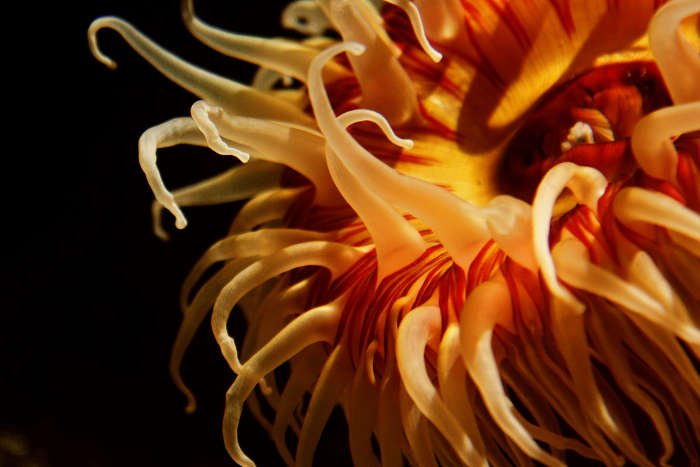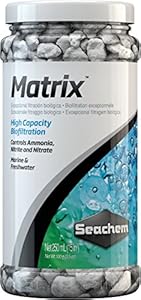Biological filtration has always been a major topic for discussion with freshwater and marine aquarists.
Biological filtration is a very general term relating to water purification performed by bacteria. Most aquarists think of ammonia and nitrite removal when biological filtration is mentioned. Reef enthusiasts include biological nitrate reduction in the discussion.

(source)
Biological filtration media is a type of filter media designed to provide a place for the bacteria to settle on and form stable colonies.
Before we review different biological filter media, let’s take a closer look at the microbes that make biological filtration happen in our aquariums.
Bacteria and biological filtration
The truth about bacteria and biological filtration
Why do I need special biofilter media?
What order do I use biofilter media in my filter?
How much biofilter media do I need?
What type of biofilter media should I use?
Recommended Biofilter Media Reviews
1. Fluval BioMax Bio Rings
Fluval BIOMAX bio rings are composed of silica and aluminum oxide formed into a porous ring.
The internal pore system provides a surface for nitrifying and denitrifying bacteria to colonize.
As pores capture debris a natural balance of ammonia, nitrite and nitrate removal occurs.
BIOMAX bio rings have more capacity than smooth biological filter media.
The rings have a hole in the center that allows water movement throughout the media to ensure optimal contact time for efficient biological filtration.
Pros
- Can be used in a canister filter as loose bio media.
- Can be poured into a filter bag for easy removal.
- Inexpensive.
- Allows denitrification.
- Suitable for all aquariums.
Cons
- Manufacturer recommends replacing some media every six months.
2. Fluval Bio Foam
Fluval Bio Foam is manufactured from a dense, porous foam material.
Bio Foam is cut specifically to fit in Fluval filters.
The foam acts as a prefilter, capturing fine debris.
There is a lot of surface area in the foam for nitrifying bacteria too.
If the Bio Foam is not cleaned frequently it can become clogged and reduce the flow rate through the filter.
Sponge biofilter media are best suited for freshwater aquariums. Saltwater can make some foams brittle.
Pros
- Custom-fit for Fluval filters.
- High surface area.
- Inexpensive.
- Easy to clean.
Cons
- Can become clogged and reduce flow rate.
- Must be used with Fluval filters.
- Cleaning disturbs the bacteria.
3. Seachem Matrix
Matrix is a solid pumice biomedia processed to form 10-mm pebbles.
The surface of the Matrix media provides a rough surface for bacterial attachment.
One liter of Matrix™ provides as much surface area (>700 square meters) as 170 liters of plastic balls, according to the manufacturer.
Matrix provides both external and internal “macroporous” surface area.
The macropores are large enough for nitrifying and denitrifying bacteria to get inside. This feature, unlike other non-porous biomedia, allows bacteria to remove nitrate along with ammonia and nitrite at the same time.
Use one 250 ml jar for up to 25 US gallons of aquarium water.
Matrix is recommended for all aquariums but is especially useful for reducing nitrate.
Pros
- Can be used loose or in a filter bag.
- Never needs to be replaced.
- Can be rinsed without harming the bacteria.
- Removes nitrate, nitrite and ammonia.
Cons
- May need to use larger Pond Matrix in drip tray systems.
4. Eheim Substrat Pro
Substrat Pro is a German biofilter material.
Fine glass particles are compressed or “sintered” into porous beads.
The porosity of the bead can be controlled by the sintering process.
Sintered glass has been used in laboratories to grow bacteria.
Eheim took this technology and created a sintered bead for biological filtration in aquariums.
Eheim makes Substrat Pro for their range of canister filters but the beads can be used in any canister filter tray.
Substat Pro is best suited for large canister filters that have room for the beads. Best for freshwater and marine fish aquariums.
Pros
- Inert glass does not break down in the aquarium.
- Beads can be rinsed to clean them.
- Removes nitrate, nitrite and ammonia.
- Compatible with freshwater and marine aquariums.
Cons
- Expensive.
5. CerMedia MarinePure
CerMedia is a manufacturer of porous ceramic materials for industrial wastewater treatment.
The kiln-fired ceramic material has a rough surface and large porous structure.
CerMedia created a round media for aquariums, called MarinePure.
The 1.5” diameter sphere can be used in any filter that the spheres will fit into.
It is composed of aluminum oxide and silicon dioxide.
The ceramic is inert and won’t change pH or release anything into the aquarium water. Unlike closed-pore biomedia, water can freely flow through the porous ceramic.
The best way to use MarinePure would be in a canister filter or contact chamber.
Reef aquarists will appreciate the biological nitrate-reducing properties that the media promotes.
Planted aquariums reduce nitrate through plant growth and would not really benefit from this style of biofilter media.
Pros
- Open pores allow water to pass through the media.
- Strong ceramic that does not physically break down.
- Great for reef aquariums that require nitrate reduction.
Cons
- Spheres are larger than most media and take up space.
- Very expensive.
6. Marineland Biofilter Balls
Biofilter balls are traditional non-porous plastic “bio balls”.
The biofilter balls are designed for ammonia and nitrite (nitrification) only.
Water flows freely over and through the balls. There are no pores to trap debris and support denitrifying bacteria.
This is the perfect media for freshwater aquariums and planted aquariums with a canister filter.
The media never needs replacing.
Pros
- Simple biomedia that never gets dirty, or needs replacing.
- Inexpensive.
- Effective.
- Ideal for freshwater aquariums and fish-only saltwater tanks.
Cons
- Does not have nitrate-removing capacity.
7. Bio-Chem Stars
API Bio-Chem Stars are formed from medical-grade plastic.
The plastic has a porous surface along with interconnecting channels throughout the star structure.
The 50-70 micron pore network was engineered specifically for the aquatic bacteria that perform biofiltration.
This pore structure will promote stable colonies for biological ammonia, nitrite and nitrate reduction.
Bio-Chem Stars can be placed in a sump, power filter or canister filter. The biomedia floats at the water surface. They can be used in a sump or refugium.
The floating biomedia stay near the surface and above other media like sponges and activated carbon. Only two Stars are need per ten gallons of water.
Pros
- Made specifically for nitrifying and denitrifying bacteria.
- Safe, medical grade porous plastic won’t break down.
- Can be used in any filter or sump.
- Two Stars per gallons.
- Does not take up a lot of room inside the filter.
- 50-70 micron pore network.
Cons
- Could be expensive if you want to fill up a large canister filter.
My Pick
The good news is that all of these biofiltration media work as described.
The main decision points will be the need for nitrate removal, cost and available space in your aquarium’s filter system.
Marineland Biofilter Balls will work well for fish-only and planted aquariums.
Seachem Matrix is an effective and reasonably-priced biofiltration media with nitrate-reducing capability.
Matrix is especially useful in reef aquariums where nitrate removal is highly desirable.
CerMedia MarinePure is expensive but offers a high-porosity flow-through design not found in other biological filter media.
MarinePure is recommended if your reef tank has an on-going nitrate problem.






